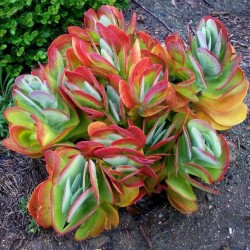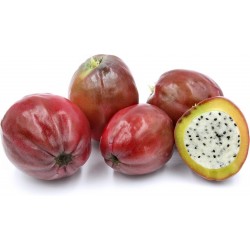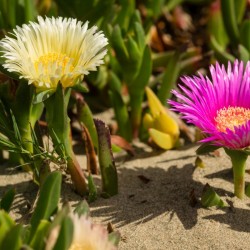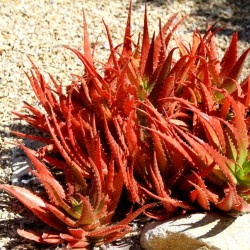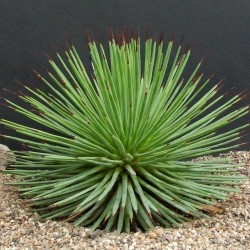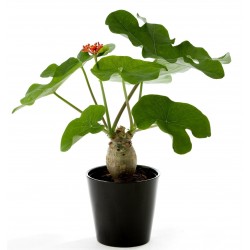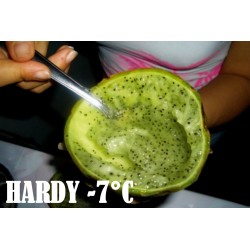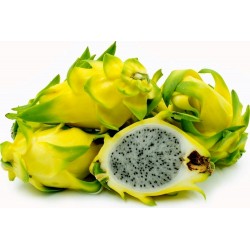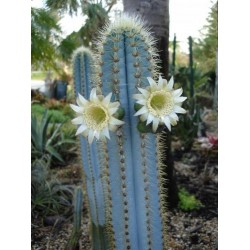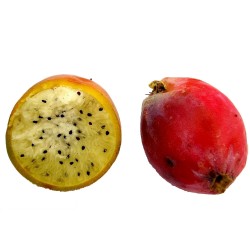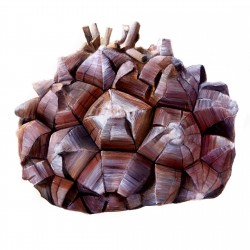
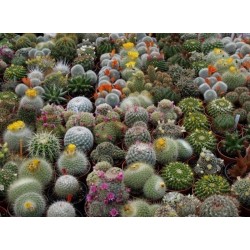
Κατάλογος των ειδών κάκτων...
Τιμή
0,00 €
SKU: 0000030
Seeds Gallery Com,
5/
5
<h2><span style="text-decoration:underline;"><em><strong>Κατάλογος των ειδών κάκτων στην Κόκκινη Λίστα των απειλούμενων ειδών</strong></em></span></h2>
<h3><em><strong> </strong></em></h3>
<table class="wikitable sortable float-left"><tbody><tr><td><span style="color:#008000;"><strong><em>Acharagma aguirreanum</em></strong></span></td>
<td><span style="color:#008000;"><strong> vom Aussterben bedroht</strong></span></td>
</tr><tr><td><span style="color:#008000;"><strong><em>Ariocarpus agavoides</em></strong></span></td>
<td><span style="color:#008000;"><strong> gefährdet</strong></span></td>
</tr><tr><td><span style="color:#008000;"><strong><em>Ariocarpus bravoanus</em></strong></span></td>
<td><span style="color:#008000;"><strong> gefährdet</strong></span></td>
</tr><tr><td><span style="color:#008000;"><strong><em>Ariocarpus bravoanus</em> subsp. <em>bravoanus</em></strong></span></td>
<td><span style="color:#008000;"><strong> vom Aussterben bedroht</strong></span></td>
</tr><tr><td><span style="color:#008000;"><strong><em>Ariocarpus bravoanus</em> subsp. <em>hintonii</em></strong></span></td>
<td><span style="color:#008000;"><strong> gefährdet</strong></span></td>
</tr><tr><td><span style="color:#008000;"><strong><em>Ariocarpus kotschoubeyanus</em></strong></span></td>
<td><span style="color:#008000;"><strong> gering gefährdet</strong></span></td>
</tr><tr><td><span style="color:#008000;"><strong><em>Ariocarpus retusus</em></strong></span></td>
<td><span style="color:#008000;"><strong> nicht gefährdet</strong></span></td>
</tr><tr><td><span style="color:#008000;"><strong><em>Ariocarpus scaphirostris</em></strong></span></td>
<td><span style="color:#008000;"><strong> gefährdet</strong></span></td>
</tr><tr><td><span style="color:#008000;"><strong><em>Ariocarpus trigonus</em></strong></span></td>
<td><span style="color:#008000;"><strong> nicht gefährdet</strong></span></td>
</tr><tr><td><span style="color:#008000;"><strong><em>Arrojadoa dinae</em></strong></span></td>
<td><span style="color:#008000;"><strong> gefährdet</strong></span></td>
</tr><tr><td><span style="color:#008000;"><strong><em>Arrojadoa eriocaulis</em></strong></span></td>
<td><span style="color:#008000;"><strong> stark gefährdet</strong></span></td>
</tr><tr><td><span style="color:#008000;"><strong><em>Arthrocereus glaziovii</em></strong></span></td>
<td><span style="color:#008000;"><strong> stark gefährdet</strong></span></td>
</tr><tr><td><span style="color:#008000;"><strong><em>Arthrocereus melanurus</em></strong></span></td>
<td><span style="color:#008000;"><strong> gefährdet</strong></span></td>
</tr><tr><td><span style="color:#008000;"><strong><em>Arthrocereus melanurus</em> subsp. <em>magnus</em></strong></span></td>
<td><span style="color:#008000;"><strong> gering gefährdet</strong></span></td>
</tr><tr><td><span style="color:#008000;"><strong><em>Arthrocereus melanurus</em> subsp. <em>melanurus</em></strong></span></td>
<td><span style="color:#008000;"><strong> gefährdet</strong></span></td>
</tr><tr><td><span style="color:#008000;"><strong><em>Arthrocereus melanurus</em> subsp. <em>odorus</em></strong></span></td>
<td><span style="color:#008000;"><strong> gefährdet</strong></span></td>
</tr><tr><td><span style="color:#008000;"><strong><em>Arthrocereus rondonianus</em></strong></span></td>
<td><span style="color:#008000;"><strong> gefährdet</strong></span></td>
</tr><tr><td><span style="color:#008000;"><strong><em>Astrophytum asterias</em></strong></span></td>
<td><span style="color:#008000;"><strong> gefährdet</strong></span></td>
</tr><tr><td><span style="color:#008000;"><strong><em>Aztekium hintonii</em></strong></span></td>
<td><span style="color:#008000;"><strong> nicht gefährdet</strong></span></td>
</tr><tr><td><span style="color:#008000;"><strong><em>Aztekium ritteri</em></strong></span></td>
<td><span style="color:#008000;"><strong> nicht gefährdet</strong></span></td>
</tr><tr><td><span style="color:#008000;"><strong><em>Brachycereus nesioticus</em></strong></span></td>
<td><span style="color:#008000;"><strong> gefährdet</strong></span></td>
</tr><tr><td><span style="color:#008000;"><strong><em>Brasilicereus markgrafii</em></strong></span></td>
<td><span style="color:#008000;"><strong> stark gefährdet</strong></span></td>
</tr><tr><td><span style="color:#008000;"><strong><em>Brasiliopuntia brasiliensis</em></strong></span></td>
<td><span style="color:#008000;"><strong> nicht gefährdet</strong></span></td>
</tr><tr><td><span style="color:#008000;"><strong><em>Cereus mirabella</em></strong></span></td>
<td><span style="color:#008000;"><strong> gefährdet</strong></span></td>
</tr><tr><td><span style="color:#008000;"><strong><em>Cipocereus bradei</em></strong></span></td>
<td><span style="color:#008000;"><strong> stark gefährdet</strong></span></td>
</tr><tr><td><span style="color:#008000;"><strong><em>Cipocereus crassisepalus</em></strong></span></td>
<td><span style="color:#008000;"><strong> gefährdet</strong></span></td>
</tr><tr><td><span style="color:#008000;"><strong><em>Cipocereus laniflorus</em></strong></span></td>
<td><span style="color:#008000;"><strong> stark gefährdet</strong></span></td>
</tr><tr><td><span style="color:#008000;"><strong><em>Cipocereus minensis</em> subsp. <em>minensis</em></strong></span></td>
<td><span style="color:#008000;"><strong> stark gefährdet</strong></span></td>
</tr><tr><td><span style="color:#008000;"><strong><em>Cipocereus pusilliflorus</em></strong></span></td>
<td><span style="color:#008000;"><strong> vom Aussterben bedroht</strong></span></td>
</tr><tr><td><span style="color:#008000;"><strong><em>Coleocephalocereus buxbaumianus</em> subsp. <em>flavisetus</em></strong></span></td>
<td><span style="color:#008000;"><strong> gefährdet</strong></span></td>
</tr><tr><td><span style="color:#008000;"><strong><em>Coleocephalocereus fluminensis</em> subsp. <em>decumbens</em></strong></span></td>
<td><span style="color:#008000;"><strong> stark gefährdet</strong></span></td>
</tr><tr><td><span style="color:#008000;"><strong><em>Coleocephalocereus purpureus</em></strong></span></td>
<td><span style="color:#008000;"><strong> vom Aussterben bedroht</strong></span></td>
</tr><tr><td><span style="color:#008000;"><strong><em>Coryphantha clavata</em></strong></span></td>
<td><span style="color:#008000;"><strong> nicht gefährdet</strong></span></td>
</tr><tr><td><span style="color:#008000;"><strong><em>Coryphantha compacta</em></strong></span></td>
<td><span style="color:#008000;"><strong> nicht gefährdet</strong></span></td>
</tr><tr><td><span style="color:#008000;"><strong><em>Coryphantha cornifera</em></strong></span></td>
<td><span style="color:#008000;"><strong> nicht gefährdet</strong></span></td>
</tr><tr><td><span style="color:#008000;"><strong><em>Coryphantha delaetiana</em></strong></span></td>
<td><span style="color:#008000;"><strong> nicht gefährdet</strong></span></td>
</tr><tr><td><span style="color:#008000;"><strong><em>Coryphantha difficilis</em></strong></span></td>
<td><span style="color:#008000;"><strong> nicht gefährdet</strong></span></td>
</tr><tr><td><span style="color:#008000;"><strong><em>Coryphantha durangensis</em> subsp. <em>cuencamensis</em></strong></span></td>
<td><span style="color:#008000;"><strong> stark gefährdet</strong></span></td>
</tr><tr><td><span style="color:#008000;"><strong><em>Coryphantha echinoidea</em></strong></span></td>
<td><span style="color:#008000;"><strong> nicht gefährdet</strong></span></td>
</tr><tr><td><span style="color:#008000;"><strong><em>Coryphantha echinus</em></strong></span></td>
<td><span style="color:#008000;"><strong> nicht gefährdet</strong></span></td>
</tr><tr><td><span style="color:#008000;"><strong><em>Coryphantha elephantidens</em></strong></span></td>
<td><span style="color:#008000;"><strong> nicht gefährdet</strong></span></td>
</tr><tr><td><span style="color:#008000;"><strong><em>Coryphantha elephantidens</em> subsp. <em>greenwoodii</em></strong></span></td>
<td><span style="color:#008000;"><strong> stark gefährdet</strong></span></td>
</tr><tr><td><span style="color:#008000;"><strong><em>Coryphantha erecta</em></strong></span></td>
<td><span style="color:#008000;"><strong> nicht gefährdet</strong></span></td>
</tr><tr><td><span style="color:#008000;"><strong><em>Coryphantha glanduligera</em></strong></span></td>
<td><span style="color:#008000;"><strong> nicht gefährdet</strong></span></td>
</tr><tr><td><span style="color:#008000;"><strong><em>Coryphantha gracilis</em></strong></span></td>
<td><span style="color:#008000;"><strong> nicht gefährdet</strong></span></td>
</tr><tr><td><span style="color:#008000;"><strong><em>Coryphantha hintoniorum</em></strong></span></td>
<td><span style="color:#008000;"><strong> gefährdet</strong></span></td>
</tr><tr><td><span style="color:#008000;"><strong><em>Coryphantha jalpanensis</em></strong></span></td>
<td><span style="color:#008000;"><strong> nicht gefährdet</strong></span></td>
</tr><tr><td><span style="color:#008000;"><strong><em>Coryphantha longicornis</em></strong></span></td>
<td><span style="color:#008000;"><strong> nicht gefährdet</strong></span></td>
</tr><tr><td><span style="color:#008000;"><strong><em>Coryphantha macromeris</em></strong></span></td>
<td><span style="color:#008000;"><strong> nicht gefährdet</strong></span></td>
</tr><tr><td><span style="color:#008000;"><strong><em>Coryphantha maiz-tablasensis</em></strong></span></td>
<td><span style="color:#008000;"><strong> stark gefährdet</strong></span></td>
</tr><tr><td><span style="color:#008000;"><strong><em>Coryphantha neglecta</em></strong></span></td>
<td><span style="color:#008000;"><strong> nicht gefährdet</strong></span></td>
</tr><tr><td><span style="color:#008000;"><strong><em>Coryphantha nickelsiae</em></strong></span></td>
<td><span style="color:#008000;"><strong> nicht gefährdet</strong></span></td>
</tr><tr><td><span style="color:#008000;"><strong><em>Coryphantha octacantha</em></strong></span></td>
<td><span style="color:#008000;"><strong> nicht gefährdet</strong></span></td>
</tr><tr><td><span style="color:#008000;"><strong><em>Coryphantha odorata</em></strong></span></td>
<td><span style="color:#008000;"><strong> gefährdet</strong></span></td>
</tr><tr><td><span style="color:#008000;"><strong><em>Coryphantha pycnacantha</em></strong></span></td>
<td><span style="color:#008000;"><strong> stark gefährdet</strong></span></td>
</tr><tr><td><span style="color:#008000;"><strong><em>Coryphantha robustispina</em> subsp. <em>robustispina</em></strong></span></td>
<td><span style="color:#008000;"><strong> stark gefährdet</strong></span></td>
</tr><tr><td><span style="color:#008000;"><strong><em>Coryphantha vogtherriana</em></strong></span></td>
<td><span style="color:#008000;"><strong> vom Aussterben bedroht</strong></span></td>
</tr><tr><td><span style="color:#008000;"><strong><em>Discocactus bahiensis</em></strong></span></td>
<td><span style="color:#008000;"><strong> stark gefährdet</strong></span></td>
</tr><tr><td><span style="color:#008000;"><strong><em>Discocactus catingicola</em></strong></span></td>
<td><span style="color:#008000;"><strong> gefährdet</strong></span></td>
</tr><tr><td><span style="color:#008000;"><strong><em>Discocactus heptacanthus</em></strong></span></td>
<td><span style="color:#008000;"><strong> keine ausreichenden Daten</strong></span></td>
</tr><tr><td><span style="color:#008000;"><strong><em>Discocactus horstii</em></strong></span></td>
<td><span style="color:#008000;"><strong> stark gefährdet</strong></span></td>
</tr><tr><td><span style="color:#008000;"><strong><em>Discocactus placentiformis</em></strong></span></td>
<td><span style="color:#008000;"><strong> gefährdet</strong></span></td>
</tr><tr><td><span style="color:#008000;"><strong><em>Discocactus pseudoinsignis</em></strong></span></td>
<td><span style="color:#008000;"><strong> stark gefährdet</strong></span></td>
</tr><tr><td><span style="color:#008000;"><strong><em>Discocactus zehntneri</em></strong></span></td>
<td><span style="color:#008000;"><strong> gefährdet</strong></span></td>
</tr><tr><td><span style="color:#008000;"><strong><em>Discocactus zehntneri</em> subsp. <em>boomianus</em></strong></span></td>
<td><span style="color:#008000;"><strong> gefährdet</strong></span></td>
</tr><tr><td><span style="color:#008000;"><strong><em>Discocactus zehntneri</em> subsp. <em>zehntneri</em></strong></span></td>
<td><span style="color:#008000;"><strong> keine ausreichenden Daten</strong></span></td>
</tr><tr><td><span style="color:#008000;"><strong><em>Echinocactus grusonii</em></strong></span></td>
<td><span style="color:#008000;"><strong> vom Aussterben bedroht</strong></span></td>
</tr><tr><td><span style="color:#008000;"><strong><em>Echinocereus knippelianus</em></strong></span></td>
<td><span style="color:#008000;"><strong> nicht gefährdet</strong></span></td>
</tr><tr><td><span style="color:#008000;"><strong><em>Epiphyllum phyllanthus</em></strong></span></td>
<td><span style="color:#008000;"><strong> nicht gefährdet</strong></span></td>
</tr><tr><td><span style="color:#008000;"><strong><em>Epithelantha micromeris</em></strong></span></td>
<td><span style="color:#008000;"><strong> nicht gefährdet</strong></span></td>
</tr><tr><td><span style="color:#008000;"><strong><em>Espostoopsis dybowskii</em></strong></span></td>
<td><span style="color:#008000;"><strong> stark gefährdet</strong></span></td>
</tr><tr><td><span style="color:#008000;"><strong><em>Facheiroa cephaliomelana</em></strong></span></td>
<td><span style="color:#008000;"><strong> gefährdet</strong></span></td>
</tr><tr><td><span style="color:#008000;"><strong><em>Facheiroa cephaliomelana</em> subsp. <em>cephaliomelana</em></strong></span></td>
<td><span style="color:#008000;"><strong> gefährdet</strong></span></td>
</tr><tr><td><span style="color:#008000;"><strong><em>Facheiroa cephaliomelana</em> subsp. <em>estevesii</em></strong></span></td>
<td><span style="color:#008000;"><strong> gefährdet</strong></span></td>
</tr><tr><td><span style="color:#008000;"><strong><em>Facheiroa ulei</em></strong></span></td>
<td><span style="color:#008000;"><strong> keine ausreichenden Daten</strong></span></td>
</tr><tr><td><span style="color:#008000;"><strong><em>Ferocactus pilosus</em></strong></span></td>
<td><span style="color:#008000;"><strong> nicht gefährdet</strong></span></td>
</tr><tr><td><span style="color:#008000;"><strong><em>Hylocereus setaceus</em></strong></span></td>
<td><span style="color:#008000;"><strong> nicht gefährdet</strong></span></td>
</tr><tr><td><span style="color:#008000;"><strong><em>Jasminocereus thouarsii</em></strong></span></td>
<td><span style="color:#008000;"><strong> gefährdet</strong></span></td>
</tr><tr><td><span style="color:#008000;"><strong><em>Lepismium cruciforme</em></strong></span></td>
<td><span style="color:#008000;"><strong> nicht gefährdet</strong></span></td>
</tr><tr><td><span style="color:#008000;"><strong><em>Lepismium houlletianum</em></strong></span></td>
<td><span style="color:#008000;"><strong> nicht gefährdet</strong></span></td>
</tr><tr><td><span style="color:#008000;"><strong><em>Lepismium warmingianum</em></strong></span></td>
<td><span style="color:#008000;"><strong> nicht gefährdet</strong></span></td>
</tr><tr><td><span style="color:#008000;"><strong><em>Leptocereus quadricostatus</em></strong></span></td>
<td><span style="color:#008000;"><strong> vom Aussterben bedroht</strong></span></td>
</tr><tr><td><span style="color:#008000;"><strong><em>Leuchtenbergia principis</em></strong></span></td>
<td><span style="color:#008000;"><strong> nicht gefährdet</strong></span></td>
</tr><tr><td><span style="color:#008000;"><strong><em>Lophophora diffusa</em></strong></span></td>
<td><span style="color:#008000;"><strong> gefährdet</strong></span></td>
</tr><tr><td><span style="color:#008000;"><strong><em>Lophophora williamsii</em></strong></span></td>
<td><span style="color:#008000;"><strong> nicht gefährdet</strong></span></td>
</tr><tr><td><span style="color:#008000;"><strong><em>Mammillaria albicoma</em></strong></span></td>
<td><span style="color:#008000;"><strong> stark gefährdet</strong></span></td>
</tr><tr><td><span style="color:#008000;"><strong><em>Mammillaria albiflora</em></strong></span></td>
<td><span style="color:#008000;"><strong> vom Aussterben bedroht</strong></span></td>
</tr><tr><td><span style="color:#008000;"><strong><em>Mammillaria anniana</em></strong></span></td>
<td><span style="color:#008000;"><strong> vom Aussterben bedroht</strong></span></td>
</tr><tr><td><span style="color:#008000;"><strong><em>Mammillaria aureilanata</em></strong></span></td>
<td><span style="color:#008000;"><strong> gefährdet</strong></span></td>
</tr><tr><td><span style="color:#008000;"><strong><em>Mammillaria berkiana</em></strong></span></td>
<td><span style="color:#008000;"><strong> vom Aussterben bedroht</strong></span></td>
</tr><tr><td><span style="color:#008000;"><strong><em>Mammillaria bocasana</em></strong></span></td>
<td><span style="color:#008000;"><strong> nicht gefährdet</strong></span></td>
</tr><tr><td><span style="color:#008000;"><strong><em>Mammillaria crinita</em></strong></span></td>
<td><span style="color:#008000;"><strong> nicht gefährdet</strong></span></td>
</tr><tr><td><span style="color:#008000;"><strong><em>Mammillaria crinita</em> subsp. <em>leucantha</em></strong></span></td>
<td><span style="color:#008000;"><strong> keine ausreichenden Daten</strong></span></td>
</tr><tr><td><span style="color:#008000;"><strong><em>Mammillaria crinita</em> subsp. <em>wildii</em></strong></span></td>
<td><span style="color:#008000;"><strong> keine ausreichenden Daten</strong></span></td>
</tr><tr><td><span style="color:#008000;"><strong><em>Mammillaria duwei</em></strong></span></td>
<td><span style="color:#008000;"><strong> stark gefährdet</strong></span></td>
</tr><tr><td><span style="color:#008000;"><strong><em>Mammillaria erythrosperma</em></strong></span></td>
<td><span style="color:#008000;"><strong> nicht gefährdet</strong></span></td>
</tr><tr><td><span style="color:#008000;"><strong><em>Mammillaria fittkaui</em> subsp. <em>fittkaui</em></strong></span></td>
<td><span style="color:#008000;"><strong> stark gefährdet</strong></span></td>
</tr><tr><td><span style="color:#008000;"><strong><em>Mammillaria formosa</em> subsp. <em>microthele</em></strong></span></td>
<td><span style="color:#008000;"><strong> stark gefährdet</strong></span></td>
</tr><tr><td><span style="color:#008000;"><strong><em>Mammillaria gasseriana</em></strong></span></td>
<td><span style="color:#008000;"><strong> gefährdet</strong></span></td>
</tr><tr><td><span style="color:#008000;"><strong><em>Mammillaria glochidiata</em></strong></span></td>
<td><span style="color:#008000;"><strong> in der Natur ausgestorben</strong></span></td>
</tr><tr><td><span style="color:#008000;"><strong><em>Mammillaria guelzowiana</em></strong></span></td>
<td><span style="color:#008000;"><strong> vom Aussterben bedroht</strong></span></td>
</tr><tr><td><span style="color:#008000;"><strong><em>Mammillaria guillauminiana</em></strong></span></td>
<td><span style="color:#008000;"><strong> in der Natur ausgestorben</strong></span></td>
</tr><tr><td><span style="color:#008000;"><strong><em>Mammillaria herrerae</em></strong></span></td>
<td><span style="color:#008000;"><strong> vom Aussterben bedroht</strong></span></td>
</tr><tr><td><span style="color:#008000;"><strong><em>Mammillaria lenta</em></strong></span></td>
<td><span style="color:#008000;"><strong> nicht gefährdet</strong></span></td>
</tr><tr><td><span style="color:#008000;"><strong><em>Mammillaria luethyi</em></strong></span></td>
<td><span style="color:#008000;"><strong> stark gefährdet</strong></span></td>
</tr><tr><td><span style="color:#008000;"><strong><em>Mammillaria marcosii</em></strong></span></td>
<td><span style="color:#008000;"><strong> vom Aussterben bedroht</strong></span></td>
</tr><tr><td><span style="color:#008000;"><strong><em>Mammillaria mathildae</em></strong></span></td>
<td><span style="color:#008000;"><strong> gefährdet</strong></span></td>
</tr><tr><td><span style="color:#008000;"><strong><em>Mammillaria mercadensis</em></strong></span></td>
<td><span style="color:#008000;"><strong> nicht gefährdet</strong></span></td>
</tr><tr><td><span style="color:#008000;"><strong><em>Mammillaria microhelia</em></strong></span></td>
<td><span style="color:#008000;"><strong> gefährdet</strong></span></td>
</tr><tr><td><span style="color:#008000;"><strong><em>Mammillaria moelleriana</em></strong></span></td>
<td><span style="color:#008000;"><strong> nicht gefährdet</strong></span></td>
</tr><tr><td><span style="color:#008000;"><strong><em>Mammillaria nana</em></strong></span></td>
<td><span style="color:#008000;"><strong> nicht gefährdet</strong></span></td>
</tr><tr><td><span style="color:#008000;"><strong><em>Mammillaria orcuttii</em></strong></span></td>
<td><span style="color:#008000;"><strong> nicht gefährdet</strong></span></td>
</tr><tr><td><span style="color:#008000;"><strong><em>Mammillaria painteri</em></strong></span></td>
<td><span style="color:#008000;"><strong> keine ausreichenden Daten</strong></span></td>
</tr><tr><td><span style="color:#008000;"><strong><em>Mammillaria pennispinosa</em></strong></span></td>
<td><span style="color:#008000;"><strong> stark gefährdet</strong></span></td>
</tr><tr><td><span style="color:#008000;"><strong><em>Mammillaria pennispinosa</em> subsp. <em>nazasensis</em></strong></span></td>
<td><span style="color:#008000;"><strong> vom Aussterben bedroht</strong></span></td>
</tr><tr><td><span style="color:#008000;"><strong><em>Mammillaria pennispinosa</em> subsp. <em>pennispinosa</em></strong></span></td>
<td><span style="color:#008000;"><strong> stark gefährdet</strong></span></td>
</tr><tr><td><span style="color:#008000;"><strong><em>Mammillaria picta</em></strong></span></td>
<td><span style="color:#008000;"><strong> nicht gefährdet</strong></span></td>
</tr><tr><td><span style="color:#008000;"><strong><em>Mammillaria pilispina</em></strong></span></td>
<td><span style="color:#008000;"><strong> nicht gefährdet</strong></span></td>
</tr><tr><td><span style="color:#008000;"><strong><em>Mammillaria rettigiana</em></strong></span></td>
<td><span style="color:#008000;"><strong> gefährdet</strong></span></td>
</tr><tr><td><span style="color:#008000;"><strong><em>Mammillaria sanchez-mejoradae</em></strong></span></td>
<td><span style="color:#008000;"><strong> vom Aussterben bedroht</strong></span></td>
</tr><tr><td><span style="color:#008000;"><strong><em>Mammillaria schwarzii</em></strong></span></td>
<td><span style="color:#008000;"><strong> vom Aussterben bedroht</strong></span></td>
</tr><tr><td><span style="color:#008000;"><strong><em>Mammillaria senilis</em></strong></span></td>
<td><span style="color:#008000;"><strong> nicht gefährdet</strong></span></td>
</tr><tr><td><span style="color:#008000;"><strong><em>Mammillaria sinistrohamata</em></strong></span></td>
<td><span style="color:#008000;"><strong> nicht gefährdet</strong></span></td>
</tr><tr><td><span style="color:#008000;"><strong><em>Mammillaria weingartiana</em></strong></span></td>
<td><span style="color:#008000;"><strong> gefährdet</strong></span></td>
</tr><tr><td><span style="color:#008000;"><strong><em>Mammillaria zeilmanniana</em></strong></span></td>
<td><span style="color:#008000;"><strong> stark gefährdet</strong></span></td>
</tr><tr><td><span style="color:#008000;"><strong><em>Melocactus azureus</em></strong></span></td>
<td><span style="color:#008000;"><strong> stark gefährdet</strong></span></td>
</tr><tr><td><span style="color:#008000;"><strong><em>Melocactus conoideus</em></strong></span></td>
<td><span style="color:#008000;"><strong> vom Aussterben bedroht</strong></span></td>
</tr><tr><td><span style="color:#008000;"><strong><em>Melocactus deinacanthus</em></strong></span></td>
<td><span style="color:#008000;"><strong> vom Aussterben bedroht</strong></span></td>
</tr><tr><td><span style="color:#008000;"><strong><em>Melocactus ferreophilus</em></strong></span></td>
<td><span style="color:#008000;"><strong> stark gefährdet</strong></span></td>
</tr><tr><td><span style="color:#008000;"><strong><em>Melocactus glaucescens</em></strong></span></td>
<td><span style="color:#008000;"><strong> vom Aussterben bedroht</strong></span></td>
</tr><tr><td><span style="color:#008000;"><strong><em>Melocactus lanssensianus</em></strong></span></td>
<td><span style="color:#008000;"><strong> keine ausreichenden Daten</strong></span></td>
</tr><tr><td><span style="color:#008000;"><strong><em>Melocactus pachyacanthus</em></strong></span></td>
<td><span style="color:#008000;"><strong> stark gefährdet</strong></span></td>
</tr><tr><td><span style="color:#008000;"><strong><em>Melocactus pachyacanthus</em> subsp. <em>pachyacanthus</em></strong></span></td>
<td><span style="color:#008000;"><strong> stark gefährdet</strong></span></td>
</tr><tr><td><span style="color:#008000;"><strong><em>Melocactus pachyacanthus</em> subsp. <em>viridis</em></strong></span></td>
<td><span style="color:#008000;"><strong> vom Aussterben bedroht</strong></span></td>
</tr><tr><td><span style="color:#008000;"><strong><em>Melocactus paucispinus</em></strong></span></td>
<td><span style="color:#008000;"><strong> stark gefährdet</strong></span></td>
</tr><tr><td><span style="color:#008000;"><strong><em>Melocactus violaceus</em></strong></span></td>
<td><span style="color:#008000;"><strong> gefährdet</strong></span></td>
</tr><tr><td><span style="color:#008000;"><strong><em>Melocactus violaceus</em> subsp. <em>margaritaceus</em></strong></span></td>
<td><span style="color:#008000;"><strong> gefährdet</strong></span></td>
</tr><tr><td><span style="color:#008000;"><strong><em>Melocactus violaceus</em> subsp. <em>ritteri</em></strong></span></td>
<td><span style="color:#008000;"><strong> vom Aussterben bedroht</strong></span></td>
</tr><tr><td><span style="color:#008000;"><strong><em>Melocactus violaceus</em> subsp. <em>violaceus</em></strong></span></td>
<td><span style="color:#008000;"><strong> gefährdet</strong></span></td>
</tr><tr><td><span style="color:#008000;"><strong><em>Micranthocereus albicephalus</em></strong></span></td>
<td><span style="color:#008000;"><strong> gering gefährdet</strong></span></td>
</tr><tr><td><span style="color:#008000;"><strong><em>Micranthocereus auriazureus</em></strong></span></td>
<td><span style="color:#008000;"><strong> stark gefährdet</strong></span></td>
</tr><tr><td><span style="color:#008000;"><strong><em>Micranthocereus dolichospermaticus</em></strong></span></td>
<td><span style="color:#008000;"><strong> keine ausreichenden Daten</strong></span></td>
</tr><tr><td><span style="color:#008000;"><strong><em>Micranthocereus polyanthus</em></strong></span></td>
<td><span style="color:#008000;"><strong> stark gefährdet</strong></span></td>
</tr><tr><td><span style="color:#008000;"><strong><em>Micranthocereus streckeri</em></strong></span></td>
<td><span style="color:#008000;"><strong> vom Aussterben bedroht</strong></span></td>
</tr><tr><td><span style="color:#008000;"><strong><em>Micranthocereus violaciflorus</em></strong></span></td>
<td><span style="color:#008000;"><strong> gefährdet</strong></span></td>
</tr><tr><td><span style="color:#008000;"><strong><em>Obregonia denegrii</em></strong></span></td>
<td><span style="color:#008000;"><strong> gefährdet</strong></span></td>
</tr><tr><td><span style="color:#008000;"><strong><em>Opuntia chaffeyi</em></strong></span></td>
<td><span style="color:#008000;"><strong> vom Aussterben bedroht</strong></span></td>
</tr><tr><td><span style="color:#008000;"><strong><em>Opuntia galapageia</em></strong></span></td>
<td><span style="color:#008000;"><strong> stark gefährdet</strong></span></td>
</tr><tr><td><span style="color:#008000;"><strong><em>Opuntia megarhiza</em></strong></span></td>
<td><span style="color:#008000;"><strong> stark gefährdet</strong></span></td>
</tr><tr><td><span style="color:#008000;"><strong><em>Opuntia monacantha</em></strong></span></td>
<td><span style="color:#008000;"><strong> nicht gefährdet</strong></span></td>
</tr><tr><td><span style="color:#008000;"><strong><em>Opuntia pachyrrhiza</em></strong></span></td>
<td><span style="color:#008000;"><strong> gefährdet</strong></span></td>
</tr><tr><td><span style="color:#008000;"><strong><em>Pelecyphora aselliformis</em></strong></span></td>
<td><span style="color:#008000;"><strong> nicht gefährdet</strong></span></td>
</tr><tr><td><span style="color:#008000;"><strong><em>Pelecyphora strobiliformis</em></strong></span></td>
<td><span style="color:#008000;"><strong> nicht gefährdet</strong></span></td>
</tr><tr><td><span style="color:#008000;"><strong><em>Pereskia aculeata</em></strong></span></td>
<td><span style="color:#008000;"><strong> nicht gefährdet</strong></span></td>
</tr><tr><td><span style="color:#008000;"><strong><em>Pereskia aureiflora</em></strong></span></td>
<td><span style="color:#008000;"><strong> gefährdet</strong></span></td>
</tr><tr><td><span style="color:#008000;"><strong><em>Pereskia bahiensis</em></strong></span></td>
<td><span style="color:#008000;"><strong> nicht gefährdet</strong></span></td>
</tr><tr><td><span style="color:#008000;"><strong><em>Pereskia grandifolia</em></strong></span></td>
<td><span style="color:#008000;"><strong> nicht gefährdet</strong></span></td>
</tr><tr><td><span style="color:#008000;"><strong><em>Pereskia grandifolia</em> subsp. <em>violacea</em></strong></span></td>
<td><span style="color:#008000;"><strong> keine ausreichenden Daten</strong></span></td>
</tr><tr><td><span style="color:#008000;"><strong><em>Pereskia stenantha</em></strong></span></td>
<td><span style="color:#008000;"><strong> nicht gefährdet</strong></span></td>
</tr><tr><td><span style="color:#008000;"><strong><em>Pierrebraunia bahiensis</em></strong></span></td>
<td><span style="color:#008000;"><strong> gefährdet</strong></span></td>
</tr><tr><td><span style="color:#008000;"><strong><em>Pilosocereus arrabidae</em></strong></span></td>
<td><span style="color:#008000;"><strong> gering gefährdet</strong></span></td>
</tr><tr><td><span style="color:#008000;"><strong><em>Pilosocereus aureispinus</em></strong></span></td>
<td><span style="color:#008000;"><strong> keine ausreichenden Daten</strong></span></td>
</tr><tr><td><span style="color:#008000;"><strong><em>Pilosocereus aurisetus</em> subsp. <em>aurilanatus</em></strong></span></td>
<td><span style="color:#008000;"><strong> stark gefährdet</strong></span></td>
</tr><tr><td><span style="color:#008000;"><strong><em>Pilosocereus azulensis</em></strong></span></td>
<td><span style="color:#008000;"><strong> vom Aussterben bedroht</strong></span></td>
</tr><tr><td><span style="color:#008000;"><strong><em>Pilosocereus brasiliensis</em> subsp. <em>brasiliensis</em></strong></span></td>
<td><span style="color:#008000;"><strong> gefährdet</strong></span></td>
</tr><tr><td><span style="color:#008000;"><strong><em>Pilosocereus catingicola</em> subsp. <em>salvadorensis</em></strong></span></td>
<td><span style="color:#008000;"><strong> gering gefährdet</strong></span></td>
</tr><tr><td><span style="color:#008000;"><strong><em>Pilosocereus floccosus</em></strong></span></td>
<td><span style="color:#008000;"><strong> gering gefährdet</strong></span></td>
</tr><tr><td><span style="color:#008000;"><strong><em>Pilosocereus floccosus</em> subsp. <em>floccosus</em></strong></span></td>
<td><span style="color:#008000;"><strong> gering gefährdet</strong></span></td>
</tr><tr><td><span style="color:#008000;"><strong><em>Pilosocereus floccosus</em> subsp. <em>quadricostatus</em></strong></span></td>
<td><span style="color:#008000;"><strong> gefährdet</strong></span></td>
</tr><tr><td><span style="color:#008000;"><strong><em>Pilosocereus fulvilanatus</em></strong></span></td>
<td><span style="color:#008000;"><strong> gefährdet</strong></span></td>
</tr><tr><td><span style="color:#008000;"><strong><em>Pilosocereus fulvilanatus</em> subsp. <em>fulvilanatus</em></strong></span></td>
<td><span style="color:#008000;"><strong> gefährdet</strong></span></td>
</tr><tr><td><span style="color:#008000;"><strong><em>Pilosocereus fulvilanatus</em> subsp. <em>rosae</em></strong></span></td>
<td><span style="color:#008000;"><strong> vom Aussterben bedroht</strong></span></td>
</tr><tr><td><span style="color:#008000;"><strong><em>Pilosocereus glaucochrous</em></strong></span></td>
<td><span style="color:#008000;"><strong> gering gefährdet</strong></span></td>
</tr><tr><td><span style="color:#008000;"><strong><em>Pilosocereus magnificus</em></strong></span></td>
<td><span style="color:#008000;"><strong> gering gefährdet</strong></span></td>
</tr><tr><td><span style="color:#008000;"><strong><em>Pilosocereus multicostatus</em></strong></span></td>
<td><span style="color:#008000;"><strong> gering gefährdet</strong></span></td>
</tr><tr><td><span style="color:#008000;"><strong><em>Pilosocereus pentaedrophorus</em> subsp. <em>robustus</em></strong></span></td>
<td><span style="color:#008000;"><strong> gering gefährdet</strong></span></td>
</tr><tr><td><span style="color:#008000;"><strong><em>Pilosocereus piauhyensis</em></strong></span></td>
<td><span style="color:#008000;"><strong> gering gefährdet</strong></span></td>
</tr><tr><td><span style="color:#008000;"><strong><em>Pseudoacanthocereus brasiliensis</em></strong></span></td>
<td><span style="color:#008000;"><strong> gefährdet</strong></span></td>
</tr><tr><td><span style="color:#008000;"><strong><em>Quiabentia zehntneri</em></strong></span></td>
<td><span style="color:#008000;"><strong> nicht gefährdet</strong></span></td>
</tr><tr><td><span style="color:#008000;"><strong><em>Rhipsalis baccifera</em> subsp. <em>hileiabaiana</em></strong></span></td>
<td><span style="color:#008000;"><strong> gefährdet</strong></span></td>
</tr><tr><td><span style="color:#008000;"><strong><em>Rhipsalis cereoides</em></strong></span></td>
<td><span style="color:#008000;"><strong> gefährdet</strong></span></td>
</tr><tr><td><span style="color:#008000;"><strong><em>Rhipsalis crispata</em></strong></span></td>
<td><span style="color:#008000;"><strong> gefährdet</strong></span></td>
</tr><tr><td><span style="color:#008000;"><strong><em>Rhipsalis elliptica</em></strong></span></td>
<td><span style="color:#008000;"><strong> nicht gefährdet</strong></span></td>
</tr><tr><td><span style="color:#008000;"><strong><em>Rhipsalis floccosa</em></strong></span></td>
<td><span style="color:#008000;"><strong> nicht gefährdet</strong></span></td>
</tr><tr><td><span style="color:#008000;"><strong><em>Rhipsalis hoelleri</em></strong></span></td>
<td><span style="color:#008000;"><strong> keine ausreichenden Daten</strong></span></td>
</tr><tr><td><span style="color:#008000;"><strong><em>Rhipsalis oblonga</em></strong></span></td>
<td><span style="color:#008000;"><strong> gering gefährdet</strong></span></td>
</tr><tr><td><span style="color:#008000;"><strong><em>Rhipsalis pacheco-leonis</em></strong></span></td>
<td><span style="color:#008000;"><strong> keine ausreichenden Daten</strong></span></td>
</tr><tr><td><span style="color:#008000;"><strong><em>Rhipsalis pacheco-leonis</em> subsp. <em>catenulata</em></strong></span></td>
<td><span style="color:#008000;"><strong> keine ausreichenden Daten</strong></span></td>
</tr><tr><td><span style="color:#008000;"><strong><em>Rhipsalis paradoxa</em></strong></span></td>
<td><span style="color:#008000;"><strong> nicht gefährdet</strong></span></td>
</tr><tr><td><span style="color:#008000;"><strong><em>Rhipsalis paradoxa</em> subsp. <em>septentrionalis</em></strong></span></td>
<td><span style="color:#008000;"><strong> stark gefährdet</strong></span></td>
</tr><tr><td><span style="color:#008000;"><strong><em>Rhipsalis pilocarpa</em></strong></span></td>
<td><span style="color:#008000;"><strong> gefährdet</strong></span></td>
</tr><tr><td><span style="color:#008000;"><strong><em>Rhipsalis russellii</em></strong></span></td>
<td><span style="color:#008000;"><strong> gefährdet</strong></span></td>
</tr><tr><td><span style="color:#008000;"><strong><em>Rhipsalis sulcata</em></strong></span></td>
<td><span style="color:#008000;"><strong> keine ausreichenden Daten</strong></span></td>
</tr><tr><td><span style="color:#008000;"><strong><em>Schlumbergera kautskyi</em></strong></span></td>
<td><span style="color:#008000;"><strong> stark gefährdet</strong></span></td>
</tr><tr><td><span style="color:#008000;"><strong><em>Schlumbergera microsphaerica</em></strong></span></td>
<td><span style="color:#008000;"><strong> keine ausreichenden Daten</strong></span></td>
</tr><tr><td><span style="color:#008000;"><strong><em>Schlumbergera opuntioides</em></strong></span></td>
<td><span style="color:#008000;"><strong> gering gefährdet</strong></span></td>
</tr><tr><td><span style="color:#008000;"><strong><em>Tacinga braunii</em></strong></span></td>
<td><span style="color:#008000;"><strong> gefährdet</strong></span></td>
</tr><tr><td><span style="color:#008000;"><strong><em>Tacinga estevesii</em></strong></span></td>
<td><span style="color:#008000;"><strong> gefährdet</strong></span></td>
</tr><tr><td><span style="color:#008000;"><strong><em>Tacinga funalis</em></strong></span></td>
<td><span style="color:#008000;"><strong> nicht gefährdet</strong></span></td>
</tr><tr><td><span style="color:#008000;"><strong><em>Tacinga inamoena</em></strong></span></td>
<td><span style="color:#008000;"><strong> nicht gefährdet</strong></span></td>
</tr><tr><td><span style="color:#008000;"><strong><em>Tacinga palmadora</em></strong></span></td>
<td><span style="color:#008000;"><strong> nicht gefährdet</strong></span></td>
</tr><tr><td><span style="color:#008000;"><strong><em>Tacinga saxatilis</em></strong></span></td>
<td><span style="color:#008000;"><strong> nicht gefährdet</strong></span></td>
</tr><tr><td><span style="color:#008000;"><strong><em>Tacinga werneri</em></strong></span></td>
<td><span style="color:#008000;"><strong> gefährdet</strong></span></td>
</tr><tr><td><span style="color:#008000;"><strong><em>Tephrocactus bonnieae</em></strong></span></td>
<td><span style="color:#008000;"><strong> stark gefährdet</strong></span></td>
</tr><tr><td><span style="color:#008000;"><strong><em>Thelocactus conothelos</em> subsp. <em>argenteus</em></strong></span></td>
<td><span style="color:#008000;"><strong> vom Aussterben bedroht</strong></span></td>
</tr><tr><td><span style="color:#008000;"><strong><em>Thelocactus conothelos</em> subsp. <em>aurantiacus</em></strong></span></td>
<td><span style="color:#008000;"><strong> stark gefährdet</strong></span></td>
</tr><tr><td><span style="color:#008000;"><strong><em>Thelocactus hastifer</em></strong></span></td>
<td><span style="color:#008000;"><strong> gefährdet</strong></span></td>
</tr><tr><td><span style="color:#008000;"><strong><em>Turbinicarpus alonsoi</em></strong></span></td>
<td><span style="color:#008000;"><strong> vom Aussterben bedroht</strong></span></td>
</tr><tr><td><span style="color:#008000;"><strong><em>Turbinicarpus beguinii</em></strong></span></td>
<td><span style="color:#008000;"><strong> nicht gefährdet</strong></span></td>
</tr><tr><td><span style="color:#008000;"><strong><em>Turbinicarpus beguinii</em> subsp. <em>zaragozae</em></strong></span></td>
<td><span style="color:#008000;"><strong> gefährdet</strong></span></td>
</tr><tr><td><span style="color:#008000;"><strong><em>Turbinicarpus gielsdorfianus</em></strong></span></td>
<td><span style="color:#008000;"><strong> vom Aussterben bedroht</strong></span></td>
</tr><tr><td><span style="color:#008000;"><strong><em>Turbinicarpus hoferi</em></strong></span></td>
<td><span style="color:#008000;"><strong> vom Aussterben bedroht</strong></span></td>
</tr><tr><td><span style="color:#008000;"><strong><em>Turbinicarpus horripilus</em></strong></span></td>
<td><span style="color:#008000;"><strong> gefährdet</strong></span></td>
</tr><tr><td><span style="color:#008000;"><strong><em>Turbinicarpus laui</em></strong></span></td>
<td><span style="color:#008000;"><strong> gefährdet</strong></span></td>
</tr><tr><td><span style="color:#008000;"><strong><em>Turbinicarpus lophophoroides</em></strong></span></td>
<td><span style="color:#008000;"><strong> gefährdet</strong></span></td>
</tr><tr><td><span style="color:#008000;"><strong><em>Turbinicarpus mandragora</em></strong></span></td>
<td><span style="color:#008000;"><strong> vom Aussterben bedroht</strong></span></td>
</tr><tr><td><span style="color:#008000;"><strong><em>Turbinicarpus pseudomacrochele</em></strong></span></td>
<td><span style="color:#008000;"><strong> gefährdet</strong></span></td>
</tr><tr><td><span style="color:#008000;"><strong><em>Turbinicarpus pseudomacrochele</em> subsp. <em>lausseri</em></strong></span></td>
<td><span style="color:#008000;"><strong> vom Aussterben bedroht</strong></span></td>
</tr><tr><td><span style="color:#008000;"><strong><em>Turbinicarpus pseudomacrochele</em> subsp. <em>pseudomacrochele</em></strong></span></td>
<td><span style="color:#008000;"><strong> gefährdet</strong></span></td>
</tr><tr><td><span style="color:#008000;"><strong><em>Turbinicarpus pseudopectinatus</em></strong></span></td>
<td><span style="color:#008000;"><strong> gefährdet</strong></span></td>
</tr><tr><td><span style="color:#008000;"><strong><em>Turbinicarpus saueri</em> subsp. <em>knuthianus</em></strong></span></td>
<td><span style="color:#008000;"><strong> gering gefährdet</strong></span></td>
</tr><tr><td><span style="color:#008000;"><strong><em>Turbinicarpus saueri</em> subsp. <em>nelissae</em></strong></span></td>
<td><span style="color:#008000;"><strong> vom Aussterben bedroht</strong></span></td>
</tr><tr><td><span style="color:#008000;"><strong><em>Turbinicarpus saueri</em> subsp. <em>saueri</em></strong></span></td>
<td><span style="color:#008000;"><strong> vom Aussterben bedroht</strong></span></td>
</tr><tr><td><span style="color:#008000;"><strong><em>Turbinicarpus schmiedickeanus</em></strong></span></td>
<td><span style="color:#008000;"><strong> gering gefährdet</strong></span></td>
</tr><tr><td><span style="color:#008000;"><strong><em>Turbinicarpus schmiedickeanus</em> subsp. <em>andersonii</em></strong></span></td>
<td><span style="color:#008000;"><strong> vom Aussterben bedroht</strong></span></td>
</tr><tr><td><span style="color:#008000;"><strong><em>Turbinicarpus schmiedickeanus</em> subsp. <em>bonatzii</em></strong></span></td>
<td><span style="color:#008000;"><strong> stark gefährdet</strong></span></td>
</tr><tr><td><span style="color:#008000;"><strong><em>Turbinicarpus schmiedickeanus</em> subsp. <em>dickisoniae</em></strong></span></td>
<td><span style="color:#008000;"><strong> vom Aussterben bedroht</strong></span></td>
</tr><tr><td><span style="color:#008000;"><strong><em>Turbinicarpus schmiedickeanus</em> subsp. <em>flaviflorus</em></strong></span></td>
<td><span style="color:#008000;"><strong> vom Aussterben bedroht</strong></span></td>
</tr><tr><td><span style="color:#008000;"><strong><em>Turbinicarpus schmiedickeanus</em> subsp. <em>gracilis</em></strong></span></td>
<td><span style="color:#008000;"><strong> vom Aussterben bedroht</strong></span></td>
</tr><tr><td><span style="color:#008000;"><strong><em>Turbinicarpus schmiedickeanus</em> subsp. <em>jauernigii</em></strong></span></td>
<td><span style="color:#008000;"><strong> vom Aussterben bedroht</strong></span></td>
</tr><tr><td><span style="color:#008000;"><strong><em>Turbinicarpus schmiedickeanus</em> subsp. <em>klinkerianus</em></strong></span></td>
<td><span style="color:#008000;"><strong> gering gefährdet</strong></span></td>
</tr><tr><td><span style="color:#008000;"><strong><em>Turbinicarpus schmiedickeanus</em> subsp. <em>macrochele</em></strong></span></td>
<td><span style="color:#008000;"><strong> stark gefährdet</strong></span></td>
</tr><tr><td><span style="color:#008000;"><strong><em>Turbinicarpus schmiedickeanus</em> subsp. <em>rioverdensis</em></strong></span></td>
<td><span style="color:#008000;"><strong> vom Aussterben bedroht</strong></span></td>
</tr><tr><td><span style="color:#008000;"><strong><em>Turbinicarpus schmiedickeanus</em> subsp. <em>schmiedickeanus</em></strong></span></td>
<td><span style="color:#008000;"><strong> vom Aussterben bedroht</strong></span></td>
</tr><tr><td><span style="color:#008000;"><strong><em>Turbinicarpus schmiedickeanus</em> subsp. <em>schwarzii</em></strong></span></td>
<td><span style="color:#008000;"><strong> vom Aussterben bedroht</strong></span></td>
</tr><tr><td><span style="color:#008000;"><strong><em>Turbinicarpus subterraneus</em> subsp. <em>booleanus</em></strong></span></td>
<td><span style="color:#008000;"><strong> vom Aussterben bedroht</strong></span></td>
</tr><tr><td><span style="color:#008000;"><strong><em>Turbinicarpus subterraneus</em> subsp. <em>subterraneus</em></strong></span></td>
<td><span style="color:#008000;"><strong> gefährdet</strong></span></td>
</tr><tr><td><span style="color:#008000;"><strong><em>Turbinicarpus swobodae</em></strong></span></td>
<td><span style="color:#008000;"><strong> vom Aussterben bedroht</strong></span></td>
</tr><tr><td><span style="color:#008000;"><strong><em>Turbinicarpus valdezianus</em></strong></span></td>
<td><span style="color:#008000;"><strong> gefährdet</strong></span></td>
</tr><tr><td><span style="color:#008000;"><strong><em>Turbinicarpus viereckii</em></strong></span></td>
<td><span style="color:#008000;"><strong> gering gefährdet</strong></span></td>
</tr><tr><td><span style="color:#008000;"><strong><em>Uebelmannia buiningii</em></strong></span></td>
<td><span style="color:#008000;"><strong> vom Aussterben bedroht</strong></span></td>
</tr><tr><td><span style="color:#008000;"><strong><em>Uebelmannia gummifera</em></strong></span></td>
<td><span style="color:#008000;"><strong> gefährdet</strong></span></td>
</tr><tr><td><span style="color:#008000;"><strong><em>Uebelmannia pectinifera</em></strong></span></td>
<td><span style="color:#008000;"><strong> nicht gefährdet</strong></span></td>
</tr><tr><td><span style="color:#008000;"><strong><em>Uebelmannia pectinifera</em> subsp. <em>flavispina</em></strong></span></td>
<td><span style="color:#008000;"><strong> gefährdet</strong></span></td>
</tr><tr><td><span style="color:#008000;"><strong><em>Uebelmannia pectinifera</em> subsp. <em>horrida</em></strong></span></td>
<td><span style="color:#008000;"><strong> gefährdet</strong></span></td>
</tr><tr><td><span style="color:#008000;"><strong><em>Uebelmannia pectinifera</em> subsp. <em>pectinifera</em></strong></span></td>
<td><span style="color:#008000;"><strong> gefährdet<br /><br /></strong></span></td>
</tr></tbody></table><h3><span style="color:#008000;"> </span></h3>
0000030

- Μόνο Online!




